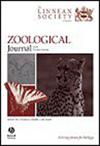来自白垩纪的回声:新化石揭示了寄生蜂超科 Orussoidea(膜翅目)中宿主检测和隐蔽产卵器的进化过程
IF 2.8
2区 生物学
Q1 ZOOLOGY
引用次数: 0
摘要
†Kryptovelona carstengroehni gen. et sp. nov.和 †Orussus juttagroehnae sp. nov.是波罗的海琥珀中记录的寄生蜂科Orussidae的第一个雌性成员。我们对它们进行了描述,包括利用同步辐射扫描技术对其内部解剖结构的相关部分进行了检查。这些化石的触角和前肢显示了一些与专门的宿主检测机制相关的改动,产卵器装置也有改动,胸部和腹部也有改动,以便容纳内化的产卵器。贝叶斯系统发生学分析表明,这些特征和其他特征的存在使它们成为虹彩蝶科的冠群成员。数据集中还包括最近从缅甸琥珀中发现的茎类兽形目化石,即可能的雌性†Cretorussus vilhelmseni和可能的雄性†Burmorussus mirabilis(均被归入Burmorussidae)。通过将新的波罗的海琥珀类群与†Cretorussus进行比较,可以通过减少触角和前肢跗节的数量来追踪回声定位机制的逐步完善。遗憾的是,†Cretorussus 没有保留腹部后部的产卵器。尽管如此,可以推断出用于宿主探测的假定的回声定位机制至少在 100 Mya 年前就已经进化了,而隐蔽的产卵器装置在大约 35 Mya 年前的化石中还没有记录。本文章由计算机程序翻译,如有差异,请以英文原文为准。
Echoes from the Cretaceous: new fossils shed light on the evolution of host detection and concealed ovipositor apparatus in the parasitoid wasp superfamily Orussoidea (Hymenoptera)
†Kryptovelona carstengroehni gen. et sp. nov. and †Orussus juttagroehnae sp. nov. are the first female members of the parasitoid wasp family Orussidae recorded from Baltic amber. We describe them, including relevant parts of the internal anatomy examined with synchrotron scanning. The fossils display a number of modifications in the antennae and foreleg correlated with the specialized host-detection mechanism, and in the ovipositor apparatus, as well as in the thorax and abdomen for accommodating the internalized ovipositor. The presence of these and other features places them as crown-group members of the Orussidae, as demonstrated by Bayesian phylogenetic analyses. The recently described stem-group orussoid fossils from Burmese amber, the probable female †Cretorussus vilhelmseni, and probable male †Burmorussus mirabilis (both placed in Burmorussidae), were also included in the dataset. By comparing the new Baltic amber taxa with †Cretorussus, it is possible to trace the progressive refinement of the echolocation mechanism through reductions in the number of antennomeres and foreleg tarsomeres. Unfortunately, †Cretorussus does not have the posterior part of the abdomen with the ovipositor preserved. Nevertheless, it is possible to infer that the putative echolocation mechanism for host detection evolved at least 100 Mya, whereas the concealed ovipositor apparatus has not been documented in fossils older than approx. 35 Mya.
求助全文
通过发布文献求助,成功后即可免费获取论文全文。
去求助
来源期刊
CiteScore
6.50
自引率
10.70%
发文量
116
审稿时长
6-12 weeks
期刊介绍:
The Zoological Journal of the Linnean Society publishes papers on systematic and evolutionary zoology and comparative, functional and other studies where relevant to these areas. Studies of extinct as well as living animals are included. Reviews are also published; these may be invited by the Editorial Board, but uninvited reviews may also be considered. The Zoological Journal also has a wide circulation amongst zoologists and although narrowly specialized papers are not excluded, potential authors should bear that readership in mind.

 求助内容:
求助内容: 应助结果提醒方式:
应助结果提醒方式:


